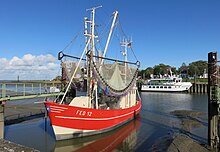Voss shipyard
| Voss-Werft & Stahlbau GmbH | |
|---|---|
| legal form | Company with limited liability |
| Seat | Ihlow , district of Westerende-Kirchloog |
| management | Lars Heyen |
| Branch | Shipbuilding and steel construction |
| Website | www.voss-werft.de |
The Voß-Werft & Stahlbau GmbH is the successor company of the well-known ship and boat yard Lübbe Voss . It is based in Westerende-Kirchloog , a part of the municipality of Ihlow and is one of the few shipyards in the East Frisian inland that has successfully made the transition from timber to steel shipbuilding .
Operation Ihlowerfehn
The first Voss shipyard was founded in Ihlowerfehn in the mid-19th century by the boat builder Voss, who immigrated from the Netherlands . Lübbe Voss, one of his sons, continued to run the business until he died in 1896. His oldest son Albert was only fourteen years old. After a shortened apprenticeship, Albert Voss received the special permit to continue his parents' business. Initially it was only with minor repairs, but in 1901 he built his first peat ship. The increasing use of coal as fuel caused the demand for such ships to decline at the beginning of the 20th century.
After the First World War , only four nuts were built at the Voss shipyard , which were retrofitted with auxiliary engines. Albert Voss delivered his last ship in 1936 with the Tjalk Johanne . The price at that time was 3,200 Reichsmarks . The company was then taken over by his son Lübbe Voss (* March 9, 1912 - March 16, 2008). During the Second World War he was conscripted for Abeking & Rasmussen in Lemwerder and the shipyard in Ihlowerfehn was shut down during this time. After the war, minor repairs were carried out there again.
Westerende-Kirchloog plant

After the currency reform , Lübbe Voss moved its business to Westerende-Kirchloog on the Ems-Jade Canal . At first only wooden ships were repaired there. The first new building was an Oskar Teubert ship , which was delivered in 1956 and others followed. However, the dimensions of the Ems-Jade Canal and the boiler lock did not allow larger inland vessels and so production was switched to excursion boats , yachts and fishing vessels . The first shrimp cutter was delivered to Accumersiel in 1967 . It was the beginning of a successful series of over 100 cutters on the North and Baltic Sea coasts. In 1985 the prices for a cutter were between 600,000 and one million German marks .
In the summer of 2005, Dirk and Lars Heyen from Westerende-Kirchloog took over the business and have been running it as Voß-Werft & Stahlbau GmbH ever since. Ships up to 45 meters long can be pulled out of the water with a slipway and revised in the shipyard. In addition, new constructions and repairs in the steel , stainless steel and aluminum sectors are offered.
New buildings
Many of the over 140 ships built by the shipyard are still in service. Of the passenger ships, these are the coat of arms from Juist (built in 1968) on Juist , the Eilun (1970) in Steenodde , the Dollard (1972) in Ditzum , the Horizont (1982) in Harlesiel and the Spitzhörn (1990) in Barßel .
Web links
Individual evidence
- ↑ a b Karl-Heinz Wiechers: ... and drove far across the sea . On the history of the East Frisian sailing ship. 2nd Edition. Volume III: The Fehne. Soltau-Kurier, Norden 1997, p. 38-39 .
- ↑ Gerold Conradi: NEW225-a. In: Fishing ports in Europe. Retrieved December 6, 2016 .
- ↑ A busy industry. (No longer available online.) Weser-Ems Manager, archived from the original on December 6, 2016 ; accessed on December 6, 2016 . Info: The archive link was inserted automatically and has not yet been checked. Please check the original and archive link according to the instructions and then remove this notice.
Coordinates: 53 ° 26 '12.8 " N , 7 ° 25' 21.4" E
